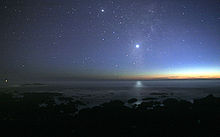Venus
| Part of | inner Solar System |
|---|---|
| Get use | terraforming of Venus, colonization of Venus |
| IPA transcription | ˈveːnʊs |
| Dem name after | Venus |
| Demonym | Venusian, Venerian, Venusano, Vénusien, زُهَرِيٌّ |
| Ein location | inner Solar System |
| Highest point | Skadi Mons |
| Lowest point | Diana Chasma |
| Studied in | observations and explorations of Venus |
| Child astronomical body | |
| Parent astronomical body | Sun |
| Get characteristic | orbit of Venus, life on Venus |
| Notation | Venus symbol |
| Epoch | J2000.0 |
| Stack Exchange tag | https://astronomy.stackexchange.com/tags/venus |
| Unicode character | ♀ |
Venus (symbol: ![]() ) be de second planet for de sun. Ebe rocky planet plus de densest atmosphere of all de rocky bodies for de Solar System insyd, wey ebe de only one plus mass den size wey be close to dat of ein orbital neighbour Earth. Edey orbit inferiorly (insyd of Earth ein orbit), edey always appear for de Earth ein sky close go de Sun, as either "morning star" anaa "evening star". While dis sanso be true give Mercury, Venus dey appear much more prominently, since ebe de third brightest object for Earth ein sky insyd afta de Moon den de Sun,[1][2] dey appear brighter dan any oda star-like classical planet anaa any fixed star. Plus such prominence insyd Earth ein sky, Venus historically be common den important object give humans, for both dema cultures den astronomy insyd.
) be de second planet for de sun. Ebe rocky planet plus de densest atmosphere of all de rocky bodies for de Solar System insyd, wey ebe de only one plus mass den size wey be close to dat of ein orbital neighbour Earth. Edey orbit inferiorly (insyd of Earth ein orbit), edey always appear for de Earth ein sky close go de Sun, as either "morning star" anaa "evening star". While dis sanso be true give Mercury, Venus dey appear much more prominently, since ebe de third brightest object for Earth ein sky insyd afta de Moon den de Sun,[1][2] dey appear brighter dan any oda star-like classical planet anaa any fixed star. Plus such prominence insyd Earth ein sky, Venus historically be common den important object give humans, for both dema cultures den astronomy insyd.


References
[edit | edit source]- ↑ Lawrence, Pete (2005). "In Search of the Venusian Shadow". Digitalsky.org.uk. Archived from the original on 11 June 2012. Retrieved 13 June 2012.
- ↑ Walker, John. "Viewing Venus in Broad Daylight". Fourmilab Switzerland. Archived from the original on 29 March 2017. Retrieved 19 April 2017.

